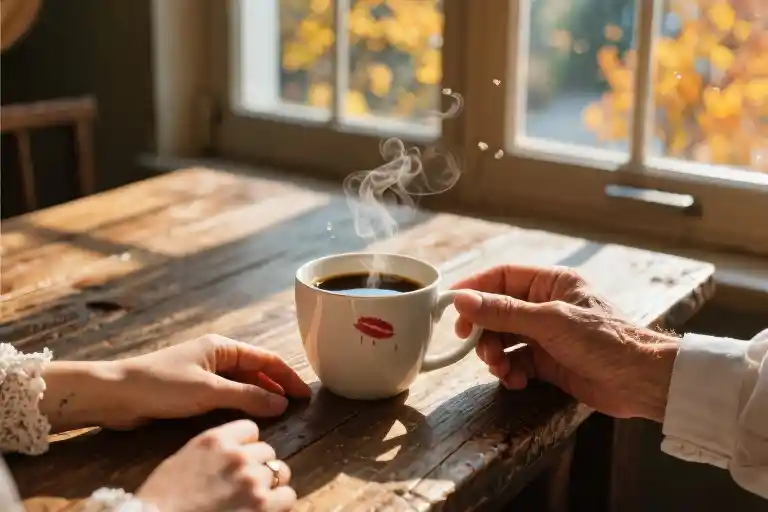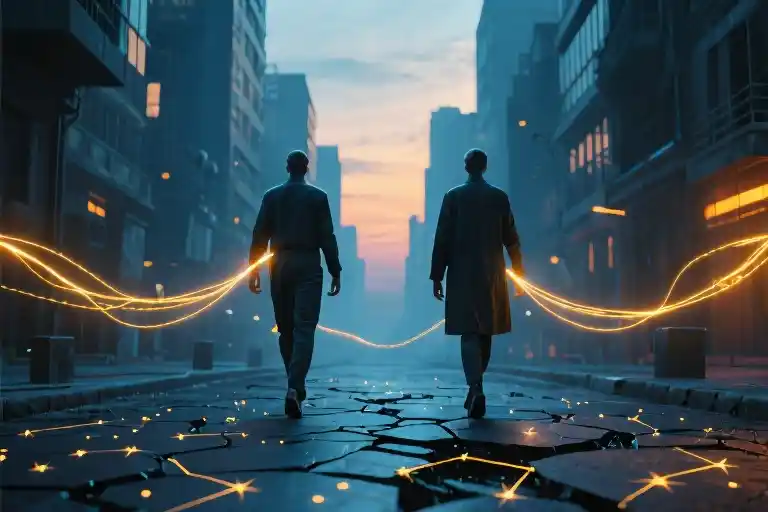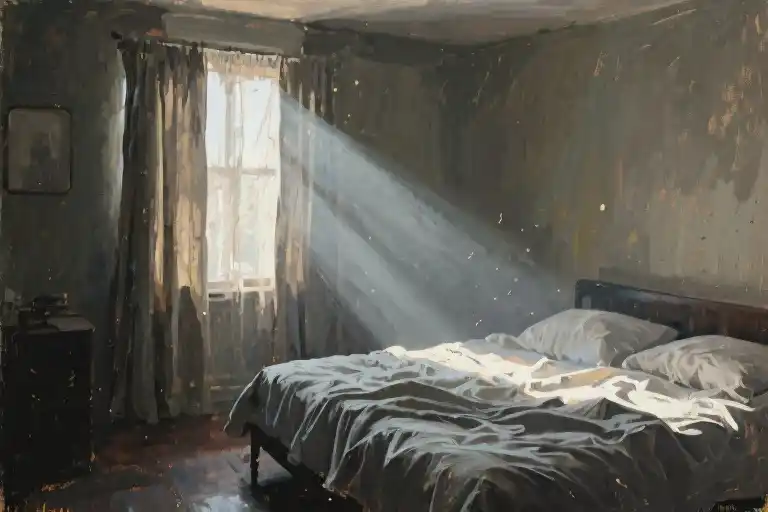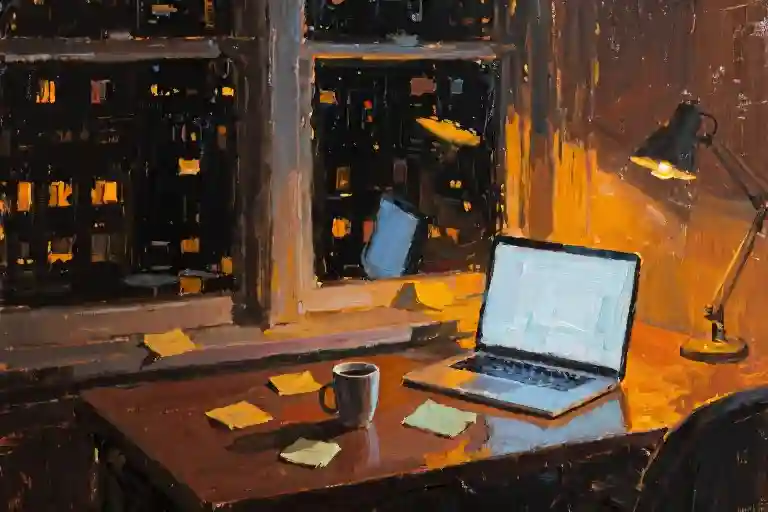The steam from my coffee cup curled between us like a translucent veil, blurring for a moment the face that mirrored my own – younger, brighter, with fewer lines around the eyes but more visible marks along the arms. She turned a page in her weathered paperback, the movement causing her sleeve to ride up just enough to reveal the constellation of bruises and needle marks I remembered too well. Our elbows rested on the same wooden table, two versions of one life separated by years yet connected by shared skin.
Sunlight through the café window caught the dust motes dancing above her open book, illuminating the careful way she aligned her teaspoon parallel to the napkin’s edge. My fingers twitched in recognition of that same compulsive neatness, now tempered by adulthood’s necessary compromises. The barista called out an order number, and in that split second when her attention shifted, I saw her – really saw her – not as memory but as flesh-and-blood presence: the chipped black nail polish, the faint scar above her eyebrow from that childhood fall, the way her collarbones still protruded slightly too much beneath the threadbare band t-shirt.
‘You’re late,’ she said without looking up, though her mouth curved at the corners. Not an accusation, just a statement of fact delivered with the easy confidence of someone who believed time would always wait for her. The scent of roasted beans and cinnamon hung between us as I slid into the opposite chair, my own hands – broader now, with a wedding band she wouldn’t recognize – wrapping around the warm ceramic. Her eyes flicked to my wrists, and I knew she’d noticed the tension there, the way my thumbs rubbed absent circles against the tendons. Some habits transcend time.
Outside the window, autumn leaves skittered across pavement in a gust that made the café’s overhead lights sway. Our reflections overlapped briefly in the glass: her hopeful tilt of chin superimposed over my tired squint, two versions of resilience wearing the same face. The barista placed a second cup before her, the espresso’s crema forming a perfect heart she wouldn’t think to photograph. Steam rose between us like all the unspoken words we’d carried across the years.
When she finally looked up, really looked, her smile faltered just for an instant – that microexpression I’d forgotten I used to make when startled. Her fingers tapped restlessly against the book’s margin, leaving no fingerprints on the pristine page. My own copy of that same novel sat on my nightstand at home, dog-eared and coffee-stained, its spine cracked from rereading. Some stories bear repeating.
The café’s ambient noise faded as she reached across to straighten my crooked teaspoon, her sleeve brushing my wrist. In that touch lingered all the conversations we’d never had with ourselves, all the warnings and reassurances that travel only one direction through time. The steam between us dissipated, and for the first time that morning, we saw each other clearly – not as past and present, but as two points on the same unbroken line.
Needle Marks and Coffee Stains
The café hummed with the quiet energy of mid-morning—steam whispering from espresso machines, porcelain clinking against saucers, the occasional burst of laughter from the corner booth. I spotted her immediately, though no one else would have noticed anything unusual. There, by the window with sunlight catching the edges of her paperback, sat my twenty-year-old self, absently rearranging sugar packets into symmetrical rows.
Our hands moved in perfect unison as I approached—she straightening a crooked napkin while I adjusted my bag strap. The synchronization made my breath catch. Her fingers paused mid-motion when she noticed me, revealing a constellation of fading bruises along her forearm. A fresh needle mark glistened near her wrist like a misplaced freckle.
“You still do that,” I said, nodding at her meticulous sugar packet grid.
“You too,” she grinned, tapping the edge of my planner where it peeked from my tote. Her smile was effortless, the kind that crinkled the corners of her eyes into crescent moons. I wondered when mine had stopped doing that.
She pushed a coffee toward me—black with one sugar, already memorized—and I noticed how her sleeve rode up when she reached across the table. More bruises. More needle tracks. The purple-green patches stood out stark against her skin, yet she moved with the unselfconscious ease of someone who’d never learned to hide them.
“We’re healed?” The question came abruptly as she caught me staring. Her thumb traced a particularly vivid mark along her inner elbow.
I watched my own fingers tighten around the mug. The heat seeped into my palms, familiar and comforting. “Not exactly.”
“Are we at least okay?” There was no fear in her voice, just pragmatic curiosity. The steam from our coffees curled between us like translucent ribbons.
“We’ll get used to it,” I said, and it wasn’t a lie. Not entirely. The words tasted bittersweet, like the coffee cooling between my hands. “We’re learning how to live with it.”
She tilted her head, sunlight catching the honey tones in her brown eyes. For a heartbeat, I saw the reflection of every doctor’s office we’d ever sat in, every unexplained symptom we’d ever tried to articulate. But then she shrugged and took a sip of her latte, leaving a faint lipstick smudge on the rim—coral pink, our signature shade from sophomore year.
“Well,” she said, licking foam from her upper lip with undisguised delight, “as long as we’re still drinking good coffee.”
A laugh bubbled up unexpectedly, startling us both. The sound felt foreign in my throat, like rediscovering a forgotten language. Outside the window, a sparrow landed on the wrought-iron café sign, its tiny chest puffing with each breath. Alive. Persistent.
My younger self watched me with quiet understanding, her fingers now tracing the water rings our glasses had left on the wooden table. Circles within circles. The patterns we couldn’t escape, the ones we’d learned to carry.
The Folded Blueprint of Dreams
A manila envelope slipped from my tote bag as I reached for my coffee, scattering loose sketches across the café floor. My younger self gasped—not at the mess, but at the familiar angular handwriting in the margins. Her fingers trembled slightly as she picked up a rendering of a sunlit reading nook, its dimensions precisely calculated to accommodate wheelchair turns.
“You kept designing?” She traced the graphite curves of what was clearly a community center ramp. The childhood dream we’d whispered about during hospital stays—creating spaces that welcomed bodies like ours—lay tangible between us in coffee-stained papers.
I watched her absorb the evidence of our persistence. Her version of success had been simple: seeing our name on an architectural firm’s door. Mine now lived in the calluses from adaptive tools, the satisfied exhaustion after accessibility consultations. We’d traded glossy magazine features for something more textured—the way a mother would grip my hand after her child could finally enter a playground.
“Is this enough?” Her question hung between us, mist rising from our matching mugs. Outside, golden hour light gilded the café’s wheelchair ramp—one I’d instinctively evaluated upon arrival. The answer came easily: “It’s different from what we imagined, but deeper.”
She folded a corner of the oldest sketch, the way we used to mark textbook pages in the rehab center. The gesture bridged our definitions—her starry-eyed benchmarks and my hard-won metrics. Success wasn’t a destination anymore, but the act of building doors where we’d once found walls.
When the waiter passed by, his shadow momentarily united our blueprints with the actual accessible tables around us. My younger self squeezed my wrist where tendonitis braces peeked from my sleeves. No triumph speech could have conveyed what that silent pressure did: recognition that every adapted dream still carried its original DNA.
The Undersweetened Latte
Her fingers tightened around my wrist before I could finish stirring the third sugar packet into my coffee. The sudden warmth startled me—her hands were so much softer than mine, untouched by years of keyboard tapping and late-night paperwork. Yet her grip held the same determination I recognized from old journal entries.
“You keep saying that,” she murmured, her thumb brushing over the faint scar along my vein. “‘This is all for you.’ But look at this.” She turned my palm upward, revealing the half-moon indents my nails had left during last week’s MRI. “When did we start lying to ourselves?”
The steam from our lattes drew fragile bridges between us as I struggled to answer. Across the table, her medical ID bracelet caught the afternoon light—a childish dolphin charm dangling beside the engraved warnings. Mine sat buried in my bag, replaced by a sleek fitness tracker that kept buzzing with stand-up reminders.
“I didn’t mean—”
“Remember our first IV?” She interrupted, tapping her straw against the rim of her glass. The ice cubes clinked like the IV pole wheels on hospital linoleum. “You held my hand through the needle and promised we’d never confuse survival with living.”
A barista’s laughter burst from the counter, slicing through our silence. When I reached to adjust my scarf—a nervous habit she hadn’t developed yet—she caught my fingers mid-air. Our shared pulse jumped under the thin skin of our wrists.
“The dreams matter,” she said, pressing my hand to the coffee-stained napkin between us. “But not if you keep using me as an excuse to bleed yourself dry.”
Outside the window, autumn leaves fell in slow spirals, the same way her childhood doodles used to flutter from hospital bed trays. I watched one cling to the glass before slipping away, realizing with sudden clarity that the “you” in my sacrifices had become someone neither of us recognized anymore.
Her phone buzzed—the retro ringtone announcing a study break alarm—while mine displayed yet another email notification. We both smiled at the synchronicity, but this time, my eyes crinkled at the corners. Just a little.
“Okay,” I whispered, turning my wrist to intertwine our fingers properly. The barista chose that moment to refill our water glasses, the condensation dripping onto the table like the tears we’d never allowed ourselves. By the time she left, my younger self had already stolen the last sugar packet from my side of the table.
“You always take the sweetest bits,” I teased, voice thick.
She popped the sugar between her lips with a grin. “Somebody’s got to remind you.”
The Unfinished Goodbye
Her fingers lingered on the rim of the half-empty coffee cup as she stood up, leaving a smudge of lipstick that matched the faded highlights in her hair. The afternoon light caught the dust motes swirling between us, and for a moment I saw all the years we’d survived suspended in that golden space.
‘Wait—’ I reached for her wrist, the one with the butterfly tattoo she’d gotten at eighteen to cover the IV scars. But she was already sliding the dog-eared book across the table toward me. That’s when the photograph fluttered out, landing face-up between the sugar packets.
My breath caught. There we were at seven years old, grinning gap-toothed on a hospital swing set, legs kicking toward a sky we believed would keep expanding forever. The edges were softened from being carried in wallets and pinned to bulletin boards through dorm rooms and first apartments. I hadn’t seen this photo in a decade.
‘You kept this?’ My voice came out rougher than intended.
She tilted her head, sunlight catching the silver hoops she still wore in both ears. ‘You stopped.’ A simple observation, no accusation. Yet it unraveled something tight behind my ribs.
The barista’s laugh rang out suddenly by the espresso machine, startling us both. When I looked back, her chair held only the imprint of her weight and those final words hanging in the air: Thank you for being alive.
I turned the photo over. On the back, in her looping adolescent handwriting: Remember we like our hot chocolate with extra whipped cream. A mundane detail from some forgotten afternoon, now glowing like a beacon. The kind of small joy we’d trained ourselves to notice during those long clinic days—proof that sweetness persisted even when veins collapsed and white coats brought bad news.
Outside the café window, a woman about her age walked by pushing a stroller, humming to the baby. Two teenagers shared earbuds on a bench. Ordinary people carrying their own invisible battles. My fingers found the raised skin along my inner elbow where the last IV had been placed, tracing the familiar ridge.
The young version of me had left more than a photograph. She’d left a question in the negative space between thank you and alive: What else had I stopped carrying forward from the girl who found wonder in foam mustaches and stubbornly wore glitter nail polish to chemotherapy?
I placed the picture carefully in the breast pocket of my jacket, right over the heart that kept beating despite every prognosis. The coffee cup still held her unfinished drink, the ice cubes melting into something that might have been tears or might have been the universe’s quiet joke about second chances. Either way, I took one deliberate sip—cold and bittersweet—before walking out into the afternoon where time moved only forward.





